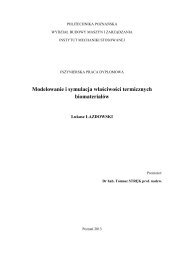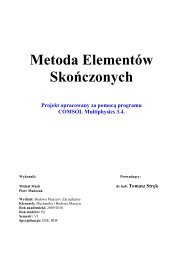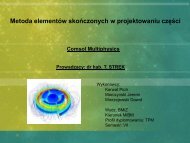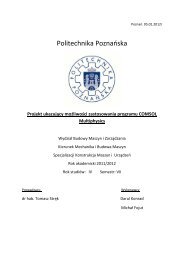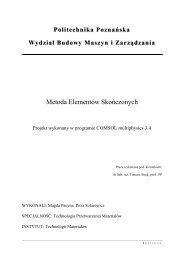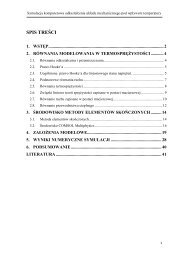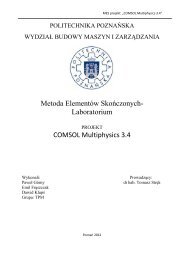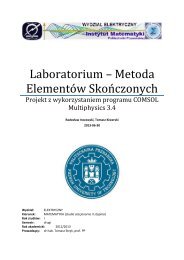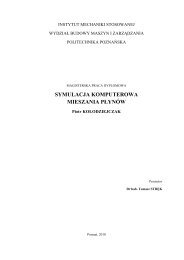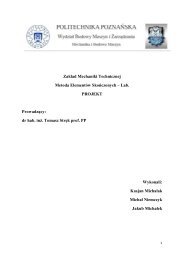Lithium-Ion Battery Simulation for Greener Ford Vehicles
Lithium-Ion Battery Simulation for Greener Ford Vehicles
Lithium-Ion Battery Simulation for Greener Ford Vehicles
Create successful ePaper yourself
Turn your PDF publications into a flip-book with our unique Google optimized e-Paper software.
PLASTICS<br />
BAM GERMAN FEDERAL INSTITUTE FOR MATERIALS RESEARCH & TESTING, BERLIN, GERMANY<br />
Modeling Helps Improve Safety in the Production of Teflon<br />
One of the most useful plastics ever discovered, Teflon, involves a dangerous manufacturing process.<br />
COMSOL Multiphysics is helping researchers determine how to identify risky situations when designing<br />
production facilities.<br />
BY MARTIN BECKMANN-KLUGE & FABIO FERRERO, BAM GERMAN FEDERAL INSTITUTE FOR MATERIALS RESEARCH & TESTING<br />
We know it as the non-stick coating<br />
Teflon, but chemists know it<br />
as PTFE (polytetrafluoroethylene). This<br />
now ubiquitous substance was discovered<br />
in 1938 by Dr. Roy J. Plunkett. This substance<br />
has since revolutionized the plastics<br />
industry and created a new branch<br />
with annual sales in the billions of dollars.<br />
Because this substance is so non-toxic,<br />
biologically inert and has excellent resistance<br />
to chemicals, organic solvents, acids<br />
and alkalis, it is used <strong>for</strong> piping and valves<br />
<strong>for</strong> the processing of aggressive chemicals<br />
and substances.<br />
Dangerous in the Making<br />
As useful as PTFE is, the polymerization<br />
process whereby TFE gas is converted<br />
into this solid can be dangerous. Not only<br />
is TFE highly flammable, it belongs to the<br />
small group of decomposable gases that<br />
are capable of exothermal reactions (those<br />
that generate heat) without the need of an<br />
oxidant. Under specific conditions that can<br />
even occur in the production process —<br />
generally when local temperatures reach<br />
the range of 500 K — an exothermic dimerization<br />
of TFE gas can start, leading<br />
to a self-heating of the gas phase. In some<br />
cases, this can in turn initiate an explosive<br />
decomposition reaction.<br />
In an ef<strong>for</strong>t to help its member companies<br />
better understand how to improve safety in<br />
PTFE production facilities and prevent future<br />
accidents, <strong>for</strong> several years the industry<br />
organization PlasticsEurope has been<br />
subsidizing experimental research and the<br />
development of a mathematical model of<br />
the self heating of TFE at the BAM Federal<br />
Institute <strong>for</strong> Materials Research and<br />
Testing in Berlin, Germany. The resulting<br />
model, created with COMSOL Multiphysics,<br />
is to our knowledge the only CFD code<br />
used to study this particular phenomenon.<br />
Until now, we have addressed this issue<br />
by conducting tests on small autoclaves<br />
where we would determine the Maximum<br />
Ignition Temperature of Decomposition<br />
(MITD). The MITD depends on the initial<br />
pressure and on the vessel geometry;<br />
Fig. 1 shows the drawing of a 3 dm 3 vessel.<br />
There<strong>for</strong>e, we would per<strong>for</strong>m test <strong>for</strong><br />
a number of initial pressure-vessel volume<br />
conditions and could interpolate between<br />
them. However, we are unable to conduct<br />
such tests on very large autoclaves of<br />
the size used in industry because of the<br />
Fig. 1. Sectional view of a 3 dm 3 vessel used <strong>for</strong><br />
the experiments to determine the Maximum Ignition<br />
Temperature of Decomposition <strong>for</strong> TFE.<br />
very high ef<strong>for</strong>t required to deal with the<br />
amount of gas and due to the extensive<br />
setup and necessary manpower.<br />
These restrictions led to the desire <strong>for</strong><br />
a mathematical model that could predict<br />
the behavior of the studied phenomenon in<br />
large autoclaves. The model was designed<br />
to simulate the self-heating process of TFE<br />
so as to determine the MITD <strong>for</strong> TFE at elevated<br />
pressures. This research will there<strong>for</strong>e<br />
help reveal the critical conditions responsible<br />
<strong>for</strong> the self-ignition of TFE.<br />
Identifying the Key Reactions<br />
A particular challenge in developing this<br />
model was to identify a suitable chemical<br />
reaction mechanism. Until now, researchers<br />
have only concerned themselves with<br />
a single reaction, the dimerization reaction<br />
where two TFE molecules “bump”<br />
into each other to create a new bigger molecule;<br />
this is the main reaction which releases<br />
energy to the gas and can result in a<br />
runaway condition if the heat builds up to<br />
critical levels. We soon learned, however,<br />
that using this reaction alone resulted in<br />
a model with poor correlation to some of<br />
the experimental results. Be<strong>for</strong>e you can<br />
model this decomposition reaction, you<br />
must also consider the many other reactions<br />
that begin parallel to dimerization.<br />
Only after extensive study and research<br />
were we able to identify many reactions<br />
that took place in the heated gas phase,<br />
but we didn’t know which ones were important<br />
<strong>for</strong> the self-heating that leads to<br />
the point of the explosion. This is where<br />
we first turned to COMSOL, specifically to<br />
the Chemical Reaction Engineering Module.<br />
In this software, which was very easy<br />
to set up, we included all of the dozen or<br />
more reactions we had identified as possibly<br />
being important. With the aid of the<br />
software we were able to find the six reactions<br />
that were needed <strong>for</strong> an accurate<br />
model and have confidence that we could<br />
omit the others <strong>for</strong> this particular study<br />
because they take place at temperatures<br />
above the self-ignition temperature, meaning<br />
they start only if the system is already<br />
experiencing a runaway.<br />
However, this first simulation assumed<br />
that the reaction was taking place in a<br />
controlled environment with a perfectly<br />
mixed system and didn’t account <strong>for</strong> local<br />
distributions. The results were lower values<br />
<strong>for</strong> the MITD compared to experimental<br />
ones, meaning that the results were<br />
on the conservative side. Furthermore, in<br />
this setup, no significant influence of the<br />
side reactions could be found unless the<br />
primary reversible dimerization reaction<br />
was included.<br />
4 4 // C O M S O L N E W S 2 0 1 1<br />
➮<br />
Cov ToC + – A<br />
➭<br />
44-45 CN BAM 2011.indd 44 5/16/11 9:31 AM



